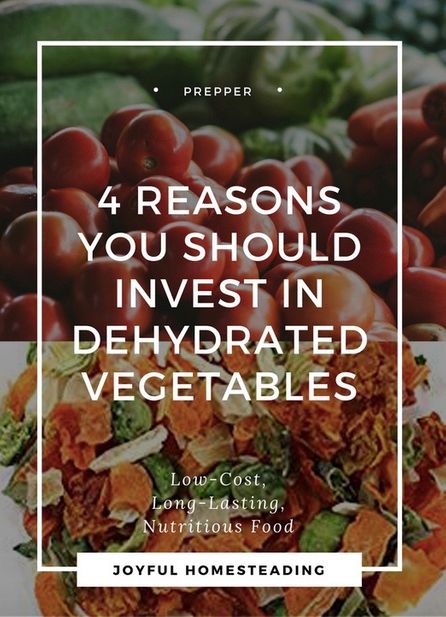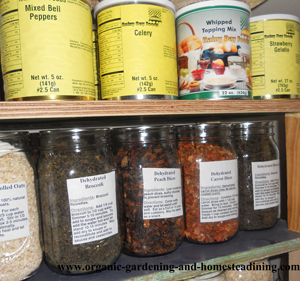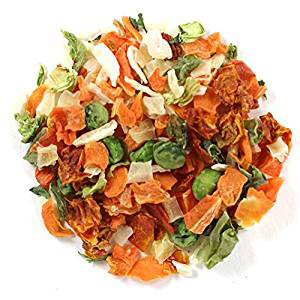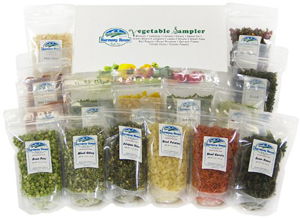Dehydrated Vegetables
Dehydrated vegetables are an excellent way to save money, add nutrition to your diet and provide security in these troubled times. That being said, I'm going to be right upfront about vegetables that have been dehydrated. They taste different. Not bad, just different and more like vegetables picked fresh from the garden.
So if you're like me and grew up a city kid who seldom tasted fresh garden produce until about the age of thirty, the dehydrated version will take some getting used to.

The Taste Comparison
I have to admit it; I like canned green beans, but I never buy them because they're loaded with salt and have very little nutrition.
We eat the dehydrated green beans, which are much better, in my opinion, than the frozen version.
Broccoli, on the other hand, is better frozen, so while I have dehydrated broccoli on hand, I still buy the frozen kind to please the kids.
The kiddos do like the dehydrated carrots, although they prefer fresh baby carrots that have been steamed. We all like the dehydrated sweet potatoes and we could eat the dehydrated hash brown potatoes just about every day and never grow tired of them. Seriously, I buy about 64 pounds of these every year.
I prefer using the dehydrated onions and celery to the fresh in soups. They're handier to use, and you can't taste the difference. But I still buy fresh onions to add to my taco meat recipe.
The dehydrated spring peas will only be good in soups and stews cooked in the crockpot. But once they are cooked properly, they taste likes peas fresh out of the garden.
The tomato powder is wonderful for making spaghetti sauce, pizza sauce and adding to soups. I can't live without it, and use it all the time in place of tomato paste. I haven't bought a can of tomato sauce or tomato paste for years. It's that good.
Cooking with Dehydrated Vegetables
To prepare vegetables that have been dehydrated, such as carrots, broccoli or green beans, put one-fourth a cup of the dried vegetables in a pot with a cup or more of water.
Bring the contents to a boil and cover, allowing the vegetables to simmer for 15 minutes. Drain and add butter, salt and pepper to taste.
To prepare the sweet potatoes and the hash browns, put one part potato and three parts water in a pot and bring it to a boil.
If you have never tasted dehydrated vegetables, a sampler pack like the one pictured above will give you a more affordable way to try them. Find it here.
The hash browns are ready to be fried as soon as they come to a boil. Don't let them boil for more than a minute or so, or they'll get mushy. Drain the hash brown potatoes and fry them like you would any hash browns.
Once sweet potatoes are brought to a boil, they will need to simmer for about ten to fifteen minutes until they are tender. Then drain them and fry them in a skillet in coconut oil with a little bit of cumin and salt (my favorite way to prepare them), or bake them in a casserole dish with butter, brown sugar and a few marshmallows thrown in (my kids' favorite way of preparing them).
So why invest in dehydrated veggies? Here are four important reasons:
Excellent for Emergencies
It's not only wise to store at least six months of food in these troubled times, it's essential. The economy may be okay, but it also may take a nosedive and rampant inflation could occur. If that happens, it may be difficult, if not impossible to buy food until the dollar, or whatever currency replaces it, stabilizes.
By buying these vegetables in bulk (twenty pounds or more of each type at a time), you can keep several months worth of food on hand. Should an emergency arise, whether a large-scale disaster or a personal one, such as the loss of a job, you will have plenty of good-quality food on hand.
Long-Lasting Value
Canned food is good for storing, but it also has the least amount of nutrients, costs the most, and is only good for about a year. Vacuum seal your dehydrated vegetables in mason jars, and they could last for up to ten years.
Takes Up Less Room
Water takes up the bulk of vegetables, whether they are fresh, frozen or canned. Dehydrated vegetables take up far less space. You can truly fit a year's supply of vegetables in a small space in your closet.
Saves Money
Canned green beans typically cost the most, while frozen vegetables cost a little bit less and have more nutrients than the canned version. But frozen vegetables take up a lot more storage space and electricity. You would have to invest in an extra freezer or two to keep six months worth of frozen vegetables, and since these vegetables are not vacuum-sealed, freezer burn becomes a problem.
Dehydrated vegetables, on the other hand, have more nutrients than both the canned and frozen versions and are cheaper if bought in bulk. Plus, if you invest in bulk (a 15 pound box of dehydrated green beans, for example) you save far more than the canned or frozen version.
The first time I ordered bulk food from Walton Feed, I spent about $700 on wheat, cocoa powder and beans, as well as dehydrated broccoli, green beans, carrots and tomato powder. This was back in 2008 when $700 was worth a lot more than it's worth today, but by doing this, we were able to cut our food costs for that year by one third.
Storage Tips
Oxygen is the destroyer of all dried foods. For the best long life, you
will need to keep both moisture and oxygen away from your dried
vegetables.
If you buy your vegetables in bulk (and you should,
if at all possible), you will need to break your vegetables down into
smaller portions.

If you can't afford a vacuum sealer, put your dehydrated vegetables in quart-sized freezer bags and seal the bags, pressing the air out as you seal them. Store the bags in five-gallon, plastic buckets to keep both the oxygen and moisture out.
While the gallon buckets will work for safely storing your foods, consider investing in a vacuum sealer and quart-sized mason jars. Using mason jars to store your food makes a huge difference in convenience and also helps avoid waste. With mason jars you can see what you have, so it's easier to keep stock of your food inventory.
That way, you'll be on top of your food storage and be prepared for whatever lies ahead.
Related article: How to dehydrate potatoes.
Learn More About Being Prepared












New! Comments
Have your say about what you just read! Leave me a comment in the box below.